Best Practices for Successful Procurement
Procurement is the process of acquiring goods or services from external sources to meet the needs of an organization and supplier sourcing is at the top of the list. It is a critical aspect of any business that involves finding the right suppliers, negotiating contracts, and managing relationships to ensure the delivery of quality products or services. One of the key challenges in procurement is finding new suppliers that can meet the organization’s specific requirements. In this blog post, we will explore the importance of new supplier sourcing and best practices for successful procurement.
Why is new supplier sourcing important?
New supplier sourcing is essential for businesses because it helps to diversify their supplier base, reduce risk, and drive innovation. By working with new suppliers, organizations can expand their product offerings, gain access to new markets, and find new ways to reduce costs. Additionally, sourcing from multiple suppliers can help to mitigate supply chain disruptions, such as natural disasters, geopolitical events, and economic downturns.
Best practices for new supplier sourcing
Define your requirements: Before you start looking for new suppliers, it’s essential to have a clear understanding of your organization’s needs. This includes the type of product or service you require, the quality standards, the delivery timelines, and any other specific requirements.
Research potential suppliers: Once you have a clear understanding of your requirements, you can start researching potential suppliers. This can involve using online directories, attending trade shows, and seeking recommendations from industry associations or other businesses.
Evaluate suppliers: After you have identified potential suppliers, it’s essential to evaluate their capabilities and assess their suitability for your organization. This can involve requesting samples, conducting site visits, and reviewing their track record with other customers. An electronic RFI (Request for Information), RFP (Request for Proposal) or RFQ (Request for Quote) software such as ProcurePort can make this process easy and efficient.
Negotiate contracts: Once you have identified a suitable supplier, it’s time to negotiate the terms of the contract. This includes pricing, delivery schedules, quality standards, and any other terms and conditions.
Establish a relationship: Once the contract is signed, it’s essential to establish a relationship with your new supplier. This can involve regular communication, feedback, and performance reviews to ensure that they are meeting your expectations. The ProcurePort Supplier Relationship Management software (SRM) allows you to collect and store all supplier information in a single repository. Additionally, it also helps with monitoring Supplier Risk and Performance.

Conclusion
New supplier sourcing is an essential aspect of procurement that can help organizations to diversify their supplier base, reduce risk, and drive innovation. By following best practices, such as defining your requirements, researching potential suppliers, evaluating their capabilities, negotiating contracts, and establishing a relationship, businesses can successfully source new suppliers and achieve their procurement objectives.










